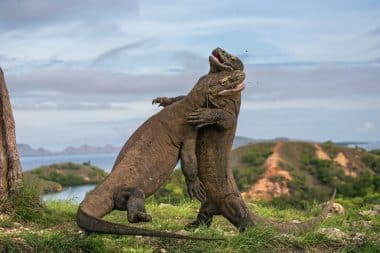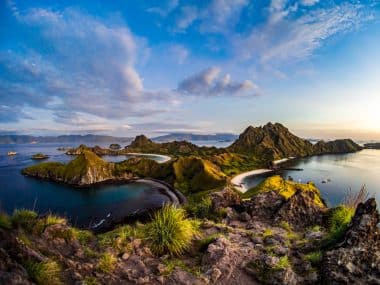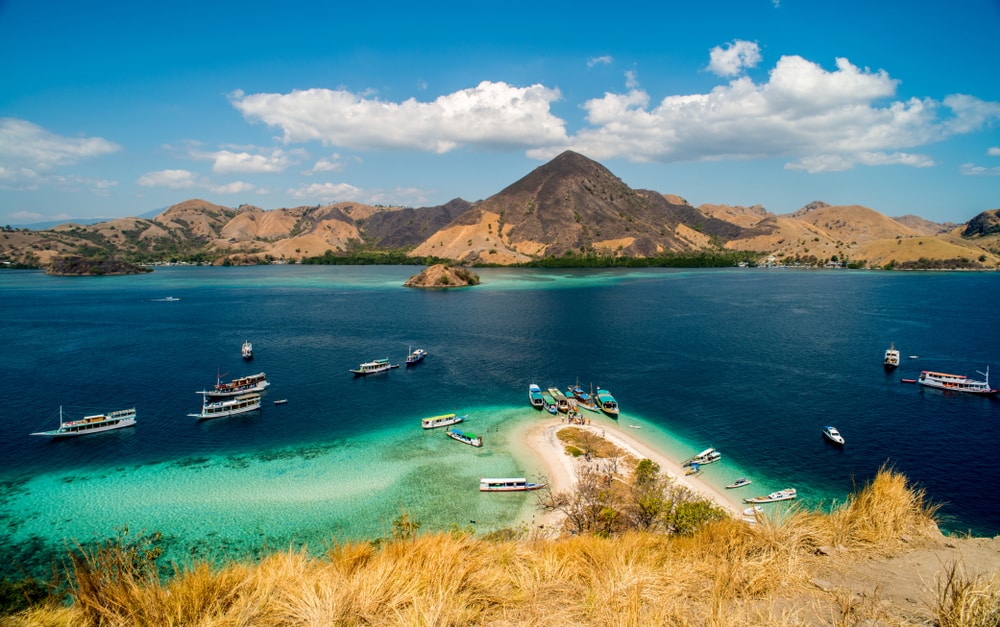Komodo is an island with an area of 390 km², which belongs to the group of the Lesser Sunda Islands. It is part of the Komodo National Park, which stretches across the chain of islands from Sumbawa to Flores and was established to protect the largest lizard species living today, the Komodo dragons. Around 10,000 tourists visit the national park every year, which can only be entered under the guidance of rangers. It was founded in 1980 and has been on the UNESCO World Heritage List since 1991. On hiking routes of different lengths, visitors have the opportunity to experience fascinating flora and fauna and to observe the reptiles, which are up to three metres long and weigh approx. 80 kg, which are often referred to as “dragons”.
Information on how to get to Komodo
Most visitors to the island fly from Denpasar in Bali to Labuan Bajo on Flores. The flight takes about one and a half hours and then continues by ship to the east coast of Komodo. A total of about 2000 people live on the island, where there is only one real village (Kampung Komodo). There are one-, two- and three-day excursions to Komodo on offer, and overnight stays are either in stilt houses or on ships if you book a cruise . If you travel to Komodo, you should be good on foot, because there is no other way to get around on land. The landscape consists of relatively rugged mountains that are between 500 and 800 meters high. At the southwestern tip is one of the very few pink beaches in the world – a paradisiacal setting for a day by the sea.
The attractions of the national park: the Komodo dragons

The huge, prehistoric reptiles have been populating the earth for about 900,000 years. Although they originally come from Australia , the 4,000 specimens of Komodo dragons that still exist today live exclusively on five islands of the Indonesian national park, whereby apart from Komodo, only Rinca and Padar may be entered. The region is also extremely interesting for scientists, as it represents a transitional area between the flora and fauna of Australia and Asia. The “dragons” are carnivores and scavengers and feed mainly on deer and water buffalo. Their bite is almost always fatal, because it triggers a shock and the venom prevents blood clotting, so that the victims die within 24 hours.
To humans, the monitor lizards usually seem rather sluggish and slow, but this impression is deceptive, because the animals can run and swim surprisingly fast as well as jump high and dive. For this reason, visitors should strictly follow the instructions of the guides armed with sticks. A Varanus komodoensis, as the scientific name is, has 60 extremely sharp teeth and a long, split tongue. During mating season, visitors to this unusual place can sometimes watch the impressive fights between two males with a bit of luck. They stand on their hind legs and tail and are actually reminiscent of dinosaurs. The females later lay about 20 eggs and after hatching, the young spend their first years of life protected in the dense crowns of the trees. Wild horses, water buffaloes, wild boars and java monkeys are also among the animal inhabitants of the island.
About 60% of the national park consists of the water areas around the islands. If you want to dive or snorkel in this colorful and diverse underwater world, you need a permit. But it’s definitely worth it, because the sea is home to more than a thousand species of fish, various whales and dolphins as well as sea turtles. The highlight for many visitors is diving with the manta rays, which also live here in large numbers. The sea in the 1,800 km² national park has temperatures of up to 29 °C – ideal for swimming and diving, although the water can also be very different in temperature at different points.
When is the best time to travel to Komodo?

For tropical areas, the region is very low in precipitation, because the dry season lasts eight months. In the period between November and March there is a rainy season in the region of the Lesser Sunda Islands and especially in February and March strong storms must be expected, which often make boat traffic impossible. Temperatures fluctuate only between 25 and 35 °C all year round. The best time to visit Komodo in terms of weather is between April and August, although it should not go unmentioned that the mating season of the monitor lizards begins in June and the animals often retreat discreetly into the forests. This means that the chance of seeing the giant lizards during a trekking tour across the island is much lower than usual.
If you are spending your holiday in Indonesia and want to experience the Komodo dragons and the rest of the exotic flora and fauna up close, you should definitely book a tour to Komodo. The area is truly one of the most unusual places on earth!
Geographical location and climate
Komodo is located between the islands of Sumbawa and Flores. The island is located in a region with a tropical climate, which is characterized by a pronounced dry and rainy season. Temperatures range from 25 to 35 degrees Celsius throughout the year, with the dry season from April to November offering the best time to visit.
The famous Komodo dragons
Komodo dragons are the largest living lizards in the world and can grow up to three meters long. They are carnivores and are known for their impressive hunting skills. Scientists estimate that around 2,500 to 3,000 of these fascinating reptiles live on the island and in the surrounding area.
Interesting facts about the dragons:
- They have a toxic saliva composition that weakens their prey.
- The lizards are extremely territorial and live mostly alone.
- Komodo dragons can overwhelm prey up to a weight of 80 kilograms.
Things to do on Komodo
The island offers much more than watching the Komodo dragons. Some of the most popular activities include:
- Trekking
There are various hiking trails that lead through the partly barren, partly jungle-like landscape. These routes offer fantastic vantage points and the chance to see wildlife in their natural habitat. - Diving and snorkeling
The waters around Komodo are among the best diving areas in the world. Here you will find coral reefs, colorful schools of fish, rays and occasionally even manta rays. - Pink Beach
Pink Beach, one of the few pink beaches in the world, is a must-see for visitors. The color is created by microscopic organisms that secrete red pigments.
Komodo National Park
Komodo National Park includes the islands of Komodo, Rinca and Padar, as well as numerous smaller islands. The park was established in 1980 to protect the Komodo dragons. Today, it is a major tourist magnet, but it also provides shelter for a variety of other animal species, including wild boar, water buffalo and birds.
Admission and fees:
Entrance fees vary due to additional costs for guides and certain activities. Since 2022, there has been a debate about introducing higher fees to curb mass tourism and better protect the environment.
Journey
Komodo is best reached via the town of Labuan Bajo on the neighboring island of Flores. Labuan Bajo has a small airport with connections from Bali and other Indonesian cities. From there, you can take a boat to Komodo, a journey that takes between 1.5 and 3 hours.
Sustainable tourism
Visiting the island requires an awareness of the delicate environment. Tourists are urged not to leave trash behind, stay on the designated paths, and not feed or disturb wildlife. The protection of Komodo dragons and their habitat is a top priority.
Interesting Facts
- Komodo National Park was named one of the “New 7 Wonders of Nature” in 2011.
- Komodo dragons have existed for over 4 million years and are considered living fossils.
- The island has a low population density; most of the locals live in the village of Kampung Komodo.


